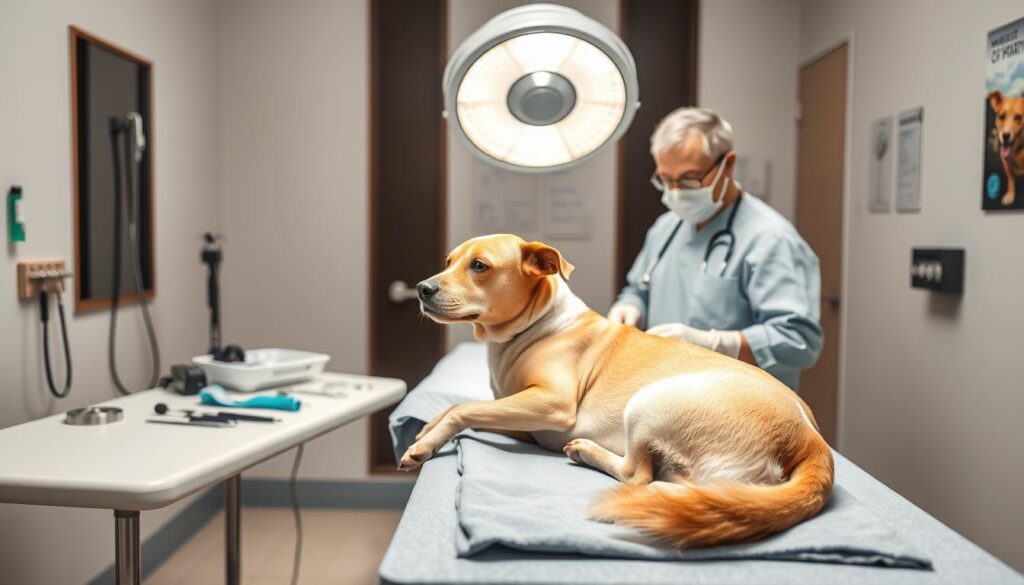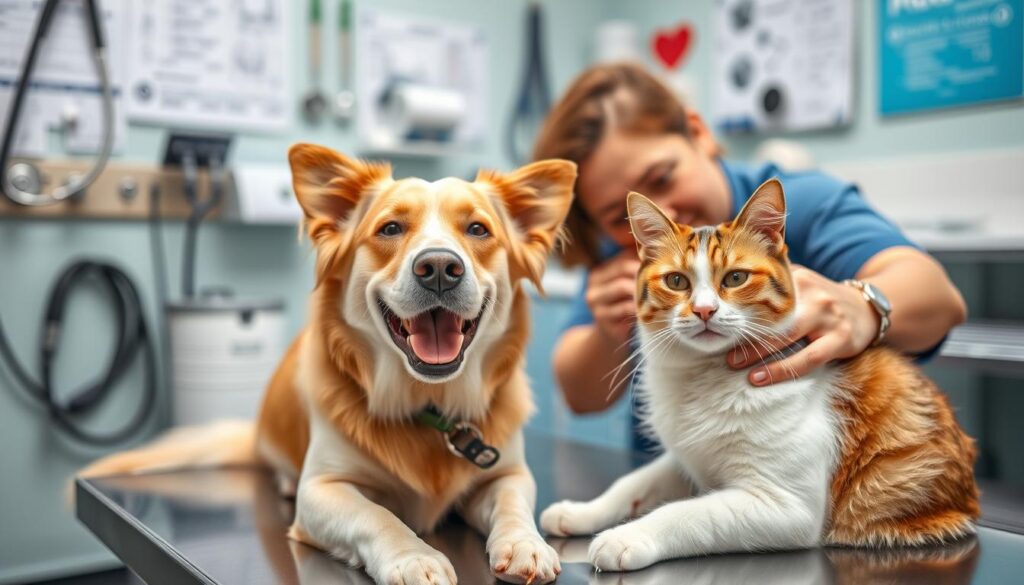Did you know that 80-90% of pets in the U.S. get spayed or neutered? Yet, many pet owners don’t know that regular pet insurance usually doesn’t cover these important procedures. But, more pet insurance companies are starting to offer special plans for neutering and spaying.
In this guide, we’ll dive into the details of pet insurance for neutering. We’ll help you understand your options and find the best plan for your pet. From the basics of pet insurance to the specifics of neutering coverage, we’ve got you covered.
Key Takeaways
- Standard pet insurance policies generally do not cover spaying and neutering, as they are considered elective procedures.
- Many pet insurance providers offer wellness plans or add-on coverage that includes spaying and neutering, with monthly costs ranging from $16 to $75.
- Companies like Lemonade, Figo, Spot, and Embrace offer specific plans or add-ons for spaying and neutering, with varying coverage limits and costs.
- Wellness plans are necessary to get reimbursed for spaying and neutering expenses, as they are not covered under standard pet insurance policies.
- The average cost to spay or neuter a pet ranges between $50 and $500, making pet insurance coverage a valuable consideration for pet owners.
Understanding Pet Insurance Basics
Exploring pet insurance can seem overwhelming, but knowing the basics is key for pet owners. Pet insurance mainly helps with unexpected illnesses and injuries. It protects your wallet from high vet bills. You pay first, then get some money back after filing a claim.
What is Pet Insurance?
Pet insurance helps cover your pet’s medical costs. It covers many treatments, from regular check-ups to emergency surgeries. This way, you can give your pet the best care without stressing over money.
How Does It Work?
Pet insurance works by reimbursing you for vet bills. You pay for services first, then claim it back. The insurance company pays a part of the bill, based on your policy and any deductibles.
Types of Pet Insurance Policies
- Accident-only policies cover sudden injuries and emergencies, like broken bones or cuts.
- Accident and illness policies cover both accidents and illnesses, like cancer or infections.
- Wellness plans are extra and cover preventive care, like check-ups and vaccinations.
Standard pet insurance doesn’t cover routine care like spaying. But, some wellness plans can include these services.
“ASPCA® Pet Health Insurance plans cover accidents, illnesses, behavioral issues, and more for cats and dogs.”
Overview of Neutering
Neutering, also known as spaying or castration, is a common surgery that stops pets from having babies. The Humane Society says 80% to 90% of pets in the U.S. have been spayed or neutered. This helps control pet numbers and can also make pets healthier.
What is Neutering?
Neutering means removing the parts that let pets have babies. For males, it’s called castration. For females, it’s called spaying. Vets do these surgeries to keep pets safe and healthy.
Benefits of Neutering
- Reduces the risk of certain types of cancer, such as ovarian, uterine, and testicular cancer.
- Helps curb unwanted behaviors, like marking territory, aggression, and roaming.
- Prevents the birth of unwanted litters, contributing to the reduction of pet overpopulation.
- Potentially extends the lifespan of pets by eliminating the risks associated with reproductive health issues.
Typical Costs of Neutering
Neutering costs can vary a lot. For dogs, it’s usually between $150 and $600. Cats are cheaper, costing between $30 to $50. Animal shelters and low-cost clinics offer cheaper options, helping more people afford it.

Most pet insurance doesn’t cover neutering because it’s not required. But some plans do. These plans cost $10 to $35 a month. They cover spaying or neutering and other vet visits.
Pet Insurance Coverage for Routine Procedures
Pet insurance usually doesn’t cover things like vaccinations and check-ups. But, many companies offer preventive pet care or wellness plans. These plans are made for routine veterinary services.
Commonly Covered Procedures
- Vaccinations
- Annual wellness exams
- Dental cleanings
- Spaying and neutering
Wellness plans don’t have deductibles or waiting periods. They’re easy to use for pet wellness coverage. But, some plans might only cover up to $150 for spaying or neutering.
Exclusions to Consider
Some plans might not cover everything. For example, they might only pay for dental cleaning or spaying/neutering once a year. It’s key to read the policy well to know what’s covered and what’s not.
| Plan | Monthly Cost | Covered Procedures | Savings |
|---|---|---|---|
| Defender | $17 | Wellness exams, vaccinations, flea/tick/heartworm prevention | 33% |
| DefenderPlus | $29 | Wellness exams, vaccinations, flea/tick/heartworm prevention, spaying/neutering, dental cleaning | 35% |
Knowing about pet wellness coverage helps pet owners make smart choices. This way, they can make sure their pets get the care they need.
Specifics of Neutering Coverage
Pet insurance can be confusing, especially when it comes to neutering. Most policies don’t cover neutering. But, there are some exceptions.
Does Standard Pet Insurance Cover Neutering?
No, standard pet insurance usually doesn’t cover neutering. These procedures are seen as preventive care. They are often not included in basic policies.
Are There Exceptions?
While neutering is not usually covered, there are some exceptions. If neutering is needed for a medical reason, like treating a uterine infection, it might be covered. Some insurance plans also offer wellness plans or preventive care add-ons. These can help pay for neutering.
Wellness plans often start right away and don’t have waiting periods. But, they might have limits on how much they can pay for certain procedures, like spay insurance and neutering coverage options.

It’s key to check the details of any pet insurance policy. Look at the pet insurance exclusions and what’s covered for neutering. Talking to a vet or the insurance company can help you understand your options better.
Factors Influencing Coverage
Several factors affect pet insurance and neutering coverage. The type of policy, provider differences, and location all play a role. These elements determine the coverage and reimbursement for this crucial procedure.
Type of Policy
Neutering is often part of wellness plans in pet insurance. These plans help with preventive care. They offer reimbursements from $150 to $200 for spaying or neutering.
However, some providers only cover neutering for pets under two years old. For example, Lemonade’s policy does this.
Provider Variations
Neutering coverage varies among pet insurance providers. Some offer different wellness plan tiers with different coverage levels. Others have just one wellness option.
The amounts reimbursed also vary. Some plans cover up to $200 for the procedure.
Geographic Location
Your location can impact neutering coverage and costs. Some areas have more providers offering this coverage. The procedure’s cost can also vary based on local vet prices.
In states like California and Florida, there are free or low-cost neutering services. These are for pet owners in need.
Understanding these factors is key for pet owners looking for the right insurance. By comparing different plans and providers, and considering location, pet owners can find the best coverage for their needs and budget.
Comparing Different Pet Insurance Providers
When looking for pet insurance for neutering, several providers stand out. Companies like ASPCA, Embrace, Fetch, Figo, Lemonade, PetsBest, and others offer different levels of coverage. They help with the cost of routine vet care, including neutering.
For instance, ASPCA’s Prime Plan covers up to $150 for neutering. Embrace’s Wellness Rewards program lets you spend up to $650 a year on all routine care, including neutering. Figo’s plans offer lower limits, with $40 to $75 for neutering. Lemonade’s puppy and kitten plan covers up to $120 for neutering.
Popular Pet Insurance Plans
- ASPCA Prime Plan: Up to $150 reimbursement for neutering
- Embrace Wellness Rewards: $250 to $650 annual flexible spending for routine care, including neutering
- Figo: $40 to $75 reimbursement for neutering
- Lemonade Puppy and Kitten Plan: Up to $120 coverage for neutering
Coverage Differences
The costs and coverage for neutering vary among pet insurance providers. It’s important for pet owners to compare these options. This way, they can find a plan that fits their budget and needs.
| Provider | Neutering Coverage | Average Monthly Cost |
|---|---|---|
| ASPCA | Up to $150 reimbursement | $25 |
| Embrace | $250 to $650 annual flexible spending | $18 to $53 |
| Fetch | Wellness plans starting at $10 with neutering coverage | Varies |
| Figo | $40 to $75 reimbursement | Varies |
| Lemonade | Up to $120 for puppy and kitten plans | $41 for kittens, $53 for puppies |
| PetsBest | BestWellness plan provides neutering coverage | $33 to $41 |
| Spot | Up to $150 reimbursement under Platinum Preventive Care | $51 |
Choosing the right pet insurance is key. Look at the coverage for neutering, as it’s a big part of pet care costs. By comparing top pet insurers and their neutering coverage options, you can make a smart choice. This ensures your pet is well-protected.

Tax Considerations for Pet Insurance
Pet insurance premiums and most pet medical costs aren’t tax-deductible for personal pets. Yet, there are exceptions and tax benefits pet owners should know about.
Deductions for Pet Medical Expenses
Pet insurance and routine vet visits for personal pets aren’t tax-deductible. But, if you have a service animal or use your pet for business, you might deduct some pet expenses. It’s wise to talk to a tax expert to see if you qualify.
Neutering as a Deductible Procedure
Neutering your pet might be tax-deductible in some cases. If a vet recommends it for health reasons, the costs could be deductible. Always check with a tax professional to make sure you’re doing it right.
Some employers offer pet insurance as a benefit, which can affect your taxes. Keep all pet medical expense records. They might be useful for tax purposes later.
“While pet insurance premiums and most pet-related medical expenses may not be directly tax-deductible for personal pets, there are some exceptions and considerations pet owners should be aware of when it comes to potential tax benefits.”
Understanding tax rules for pet insurance and vet bills can help pet owners save money. Working with a tax professional can help you make the most of your pet expenses.
Choosing the Right Pet Insurance
Choosing the right pet insurance is key when it comes to covering neutering costs. It’s important to look at what each policy offers and how much it costs. This way, you can make sure you’re getting the best deal for your pet’s health.
Evaluating Coverage Options
Many pet insurance plans include wellness coverage for neutering. These plans add $10 to $30 a month to your regular coverage. This extra cost should be weighed against the one-time neutering fee, which can be $150 to $600.
It’s also crucial to check the sublimits for neutering in wellness plans. Some plans might not cover the whole cost, leaving you with extra bills. Plans like Embrace’s Wellness Rewards let you use funds for neutering and other care as needed.
Balancing Premiums and Benefits
When picking pet insurance, think about more than just neutering. Wellness plans often cover other preventive care like vaccinations and dental cleanings. These services can save money in the long run and keep your pet healthy.
By carefully evaluating the coverage options and weighing the premiums against the potential benefits, you can choose the best policy for your budget and pet’s health. This ensures you’re getting the most out of your pet insurance.

Alternatives to Pet Insurance
Pet insurance can help with unexpected vet bills. But it might not cover all costs, like neutering. Luckily, there are other ways to get affordable pet care and financing.
Financing Neutering Costs
Low-cost clinics, animal shelters, and vet schools offer cheap neutering. Places like Pet Assure, Pawp, and AlignCare give out vouchers for low-cost care.
Vets might accept CareCredit or have payment plans. Saving money in a pet savings account is also a good idea.
Non-Insurance Payment Options
Some employers have pet savings accounts, like human health savings accounts. These can help pay for neutering. Groups like Handicapped Pets donate wheelchairs and devices for pets with special needs.
Looking into these options can help make vet care more affordable. This is true even without pet insurance.
Getting Reimbursed for Neutering
Pet owners looking to get reimbursed for neutering their pets face different processes with each insurance provider. They usually have to pay for the neutering first. Then, they can submit a claim to get some of that money back.
How Claims Work
To start a claim, pet owners need to give their insurance company a detailed invoice from the vet. Some insurers, like Trupanion, can pay the vet directly. This means the pet owner doesn’t have to pay first. But, not all providers offer this service.
Submitting claims is easy, thanks to online or mobile apps. This way, pet owners can file their pet insurance claims quickly. The amount they get back depends on their insurance plan. It might not cover the whole cost of neutering.
Documentation Needed
- Detailed invoice from the veterinary clinic
- Proof of payment for the neutering procedure
- Documentation of any pre-operative exams or follow-up care related to the neutering
Pet owners must keep all their neutering records. These are key for the neutering reimbursement process. By providing the right veterinary receipts and details, they can get the most from their insurance.

Frequently Asked Questions about Neutering
There are many myths and misconceptions about pet neutering. It’s important to know the facts and get advice from a vet. This helps you make the best choices for your pet’s health and happiness.
Common Myths
- Neutering causes weight gain and personality changes. Neutering might slow down a pet’s metabolism. But, with the right diet and exercise, they can stay at a healthy weight. It usually doesn’t change their personality, but it can reduce bad behaviors.
- Neutering is too expensive. Neutering costs can vary, but there are affordable options. Many communities offer low-cost or free programs to help control pet populations.
Clarifying Misconceptions
The best time to neuter a pet depends on its species and breed. Vets suggest spaying female pets before their first heat, usually around 5-6 months. Neutering male pets is recommended between 6-12 months. This prevents unwanted litters and lowers health risks.
| Procedure | Average Cost |
|---|---|
| Cat Neuter | $150 |
| Cat Spay | $200 |
| Dog Neuter | $250-$300 |
| Dog Spay | $300-$350 |
By understanding and debunking these myths, pet owners can make better choices. This ensures their pets stay healthy and happy for years to come.
The Future of Pet Insurance Coverage
The pet insurance world is changing fast. New trends are coming up to meet pet owners’ needs and vet tech advances. Insurers are looking into new options to support pets’ health and wellness fully.
Trends in the Industry
More pet insurance plans now include wellness coverage. Insurers see the value in preventive care. They’re offering plans that cover things like vaccinations and check-ups, and even pet insurance innovations like health trackers.
Customizable plans are also on the rise. Pet owners have different needs, and insurers are getting it. They’re offering emerging coverage options for things like acupuncture. Plus, you can adjust deductibles, co-pays, and coverage limits to fit your pet’s needs.
Future Considerations
Veterinary technology advancements are changing the game. Pet insurance companies are looking to add these new techs to their plans. This includes telemedicine for pets, making care easier and more accessible.
Insurers are also keeping up with pet owners’ changing demographics and health awareness. As the industry grows, expect more tailored, tech-savvy pet insurance. It will meet your pet’s unique needs and preferences.

Customer Experiences with Pet Insurance
Customer experiences with pet insurance vary a lot. Many people have shared good things about their insurance. They talk about how it saved them money and gave them peace of mind. Some like the wellness benefits, like covering neutering costs.
Positive Testimonials
Sarah, a pet owner, loved Pets Best Insurance. She said, “When my dog needed emergency surgery, the insurance helped a lot. It let me focus on his recovery without worrying about money.”
Olivia, who uses Embrace Pet Insurance, was happy too. She said, “The wellness rewards plan helped me a lot. I got my cat spayed at a lower cost, and the process was easy.”
Negative Experiences
Not everyone is happy with pet insurance. Some people complain about claims being denied, especially for pre-existing conditions. They also get confused about what their policy covers.
Michael was upset with Lemonade Pet Insurance. He said, “My dog’s dental cleaning claim was denied. The policy was hard to understand, and I felt alone trying to figure it out.”
Emily had a bad time with Nationwide Pet Insurance. She said, “Getting paid for my cat’s checkup took too long. I had to ask for help many times, which was frustrating.”
It seems how happy you are with pet insurance depends on a few things. Clear policy terms, quick claims, and understanding what’s covered are key. If insurance companies talk openly and clearly, customers are more likely to be happy.
Why Neutering Matters
Neutering is key for responsible pet care and our pets’ health. It helps control the pet population. This is important because nearly one million animals are euthanized in shelters each year. Neutering supports pet population control and offers health benefits for pets.
Supporting Responsible Pet Ownership
Neutering helps prevent unwanted litters and the costs that come with them. It’s a step to ensure pets don’t add to the overpopulation crisis. This leads to healthier, happier communities.
Long-term Health Benefits
Neutering has many health benefits for pets. For females, it prevents pyometra and reduces cancer risks. For males, it lowers aggression and prostate disease risks. Neutered pets often live longer than intact ones.

“Spaying and neutering are not just about population control – they’re about providing the best possible care for our beloved pets and ensuring their long-term health and wellbeing.”
By understanding the value of neutering, pet owners contribute to responsible pet care. This promotes animal welfare and fosters a more compassionate society.
Conclusion and Recommendations
When choosing pet insurance, think about your pet’s health needs and your budget. Look at the costs of wellness plans that might cover neutering. Compare these to the one-time cost of the procedure.
If neutering costs are your main worry, check out local clinics. You can also use resources like the ASPCA and Spay USA databases for affordable options.
Final Thoughts on Coverage
When picking pet insurance, do your homework. Look at different providers and understand what each policy offers. Think about your pet’s future health needs too.
Insurance is helpful, but being a good pet owner means more than just neutering. It’s about planning for all your pet’s health needs.
Steps to Take for Pet Owners
Plan for neutering early, especially if you’re adopting a pet. Talk to your vet about the best time and any health benefits for your pet.
Remember, spaying and neutering are key for controlling pet populations. They also offer health and behavioral benefits, even if they’re not legally required.


When I originally commented I clicked the “Notify me when new comments are added” checkbox and now each time a comment is added I get four emails with the same comment. Is there any way you can remove people from that service? Cheers!
Currently it seems like BlogEngine is the top blogging platform out there right now. (from what I’ve read) Is that what you are using on your blog?
great post, very informative. I wonder why the other experts of this sector do not notice this. You must continue your writing. I am sure, you’ve a huge readers’ base already!
I would like to thnkx for the efforts you have put in writing this blog. I am hoping the same high-grade blog post from you in the upcoming as well. In fact your creative writing abilities has inspired me to get my own blog now. Really the blogging is spreading its wings quickly. Your write up is a good example of it.
Hello there, I found your site by way of Google at the same time as searching for a related matter, your site came up, it appears good. I’ve bookmarked it in my google bookmarks.
Hi there! I know this is kinda off topic however , I’d figured I’d ask. Would you be interested in exchanging links or maybe guest authoring a blog article or vice-versa? My blog discusses a lot of the same subjects as yours and I believe we could greatly benefit from each other. If you might be interested feel free to shoot me an e-mail. I look forward to hearing from you! Awesome blog by the way!
Wonderful site. A lot of useful information here. I’m sending it to a few pals ans additionally sharing in delicious. And naturally, thanks for your effort!
I don’t think the title of your enticle matches the content lol. Just kidding, mainly because I had some doubts after reading the enticle.
Can you be more specific about the content of your article? After reading it, I still have some doubts. Hope you can help me.
Your article helped me a lot, is there any more related content? Thanks!
Thank you for your sharing. I am worried that I lack creative ideas. It is your article that makes me full of hope. Thank you. But, I have a question, can you help me?
Your article helped me a lot, is there any more related content? Thanks!
Your point of view caught my eye and was very interesting. Thanks. I have a question for you.
Can you be more specific about the content of your article? After reading it, I still have some doubts. Hope you can help me.
Thanks for sharing. I read many of your blog posts, cool, your blog is very good.
Your article helped me a lot, is there any more related content? Thanks!
Thank you for your sharing. I am worried that I lack creative ideas. It is your article that makes me full of hope. Thank you. But, I have a question, can you help me?
Thanks for sharing. I read many of your blog posts, cool, your blog is very good.
Lastly, we’ll carry out some cable wrist curls to strengthen our
arms additional. Bent-over cable rows, then again, supply a extra compound motion – targeting a
quantity of muscle teams located in the upper and lower again areas.
We then move on to cable rows and bent-over cable rows for extra activation of
the back muscular tissues. Seated cable rows are pretty effective at isolating and concentrating on the again muscle tissue
particularly, including the rhomboids, traps, and lats. Lastly, we’ll put the session to finish by
performing some cable shrugs to build our higher traps.
Don’t wait to discover why thousands of members choose VASA to
build power, enhance endurance, and create a healthier lifestyle.
Be A Part Of our community of members who will inspire,
inspire, and help you each step of the way. Get a free trial cross right now and experience how VASA may help you get wholesome,
feel sturdy, and reside higher. If you solely work your quads, it’ll result
in muscular imbalance that affects everything from
the greatest way you stroll and stand to your hip
and knee movement.
If the cramp won’t go away, then see a doctor as soon as you presumably can. Guarantee that your movements are gradual and controlled, particularly when dealing
with weights. Set the machine’s resistance degree according to your health stage.
It ought to be difficult but manageable to hold up correct type.
Hold a weight with each arms in entrance of you, and twist your torso to the right, then to the left, participating your
obliques. Your target should be about 8-12 twists to every side per set, aiming for three sets.
Machines present stability and support, reducing the danger of injury, especially for beginners or those recovering from accidents.
I advocate you place your feet on the top of the platform
for more glute emphasis (aka buns of steel). Understanding how all of them match collectively and work with each other will ensure you get probably the most out of your
cable leg exercise.
It was invented within the Nineteen Fifties by
golden-era fitness guru Jack LaLanne. However, engineer Paul Martin modified the original
design for health club owner Rudy Smith, which is the place the Smith machine gets its name.
Let’s reply some frequently requested questions relating to one of the best cable leg and glute workouts.
They are situated at the back of the thigh, starting underneath the
gluteus maximus and attaching to the tibia and
affecting the hip and knee motion. The quadriceps muscle tissue
are the strongest and leanest muscles in the whole
body. The entrance of the thighs is the main extensor, and these
muscles assist to increase the leg straight from the knee.
Since rowing is a fully engaged workout, your physique might
expertise some modifications in weight. This could be weight
loss, seen within the loss of fats, or weight acquire within the type of
muscle teams rising and creating more mass as they are
exercised. The Health Phantom is a database of hundreds of exercise routines and exercises that are supported by floor expertise, analysis journals, and health specialists.
The hanging knee elevate is a pull-up bar abs train,
but you can even do it on a Smith machine. The knee raises interact the decrease part
of abs and helps make your abs burlier. To carry out the reverse grip bench press, get beneath the machine, seize the bar with an underhand grip,
palms going through in, and follow the same steps as different bench presses.
The reverse grip bench press is a modified model of the bench
press.
It isolates the glutes forcing them to maneuver giant amounts
of weight via a wide range of motion. You Will construct a set of glutes like
considered one of Michaelangelo’s statues. Let’s
get one thing straight, higher rep coaching does not imply simpler.
You could have been used to lower rep squats,
hack squats and possibly leg presses. Getting into the next rep range will make certain that the
load will be positioned extra on the muscle versus the tendons
[2]. Dumping the machines and returning solely to free weights can have huge rewards.
The main muscle tissue activated when utilizing a belt squat
machine are the hamstrings, glutes, and quadriceps.
The most common variation is the 45-degree leg press which
is a plate loaded machine appropriate for both beginners and advanced health club
goers. Nonetheless, activating the gluteal muscular tissues may be achieved by performing numerous
workout routines together with the glute bridge, barbell squat, glute kickbacks and hip thrusts.
Machine workout routines also provide a safer way to attain muscle fatigue without a spotter.
Free weights are recognized to have a higher damage threat in comparability with guided machine workout routines.
Research showed that 90% of weight coaching accidents requiring emergency division visits had been caused by free-weight coaching.
Furthermore, machine workouts produce comparable outcomes as free weights.
This makes it far easier to unhook and hook the
bar once you’ve finished your set. Your muscular tissues want to maneuver via an extensive range
of movement that’ll go away you with DOMs the subsequent day.
This Smith machine reverse lunge is a superb exercise for anyone who suffers from knee pain. As you’re stepping backwards, it entails more hip motion, which places less stress in your knees.
Performing this movement on the Smith machine allows you
to focus solely on loading the legs without worrying about
your balance. Again, as the barbell is on a set plane of motion, it stabilizes the bar for you.
If you’ve struggled with stability through the regular single-leg deadlift, give this variation a go.
Cable Squats – 4 sets of 8-12 reps, with 30 seconds of
rest between sets. Because you’re not actually
carrying any weight, there could be far less pressure placed on your physique to attract your focus.
It all comes right down to “time beneath tension” (which I’ll
clarify below), which maxes out muscle growth and hypertrophy.
This is the smaller of the calf muscular tissues which sits underneath the
gastrocnemius and spans all the way down to the Achilles tendon. From
a seated position you’d lengthen the knees raising up the ankle rollers.
An essential factor to remember with this exercise is to not go too fast as this will cut back pressure to the quads and doubtlessly cause an harm.
Secondly, keep away from locking out at the knees, particularly
when lifting heavy masses, as this will put important stress on the knee joints.
The belt squat machine permits a person to duplicate a standard barbell again squat whilst decreasing
stress to the spine and correcting their squat kind.
However it can be obscure why you’d use them over grabbing a pair of dumbbells as an alternative.
Not every fitness center will have considered one of these machines,
however nearly every gym may have a cable tower that you ought to use for lower physique work.
If you’re at a barebones fitness center, or the cable machine is taken, listed
below are another options to get your glute exercises in.
Nonetheless, for specifically concentrating on your abs muscular tissues, you probably can adapt the rowing machine in a very unique and effective way.
And as a outcome of it can be adjusted flat, it doubles as a fantastic weight bench to pair with a bench press, squat rack, or Smith
machine. In reality, there are most likely more abs-focused gym machines than you can use in a single exercise.
If you’re attempting to have interaction the decrease belly
muscular tissues that work along with your hips
to move your legs, there’s a machine for that.
In this text, we are going to have a look at the most effective fitness center machines for training
abs, why you should use a machine, and extra. If you’re severe about constructing that six-pack, there are a quantity of health club machines that can allow you to to
do it correctly. With constant and habitual use,
home rowers can get your whole physique into shape because it works and strengthens
so many various muscle teams.
The advantages of hack squats embrace lowering the strain in your knees and
fascinating the muscle tissue that assist to support this critical joint.
It’s additionally more glute-focused than standard squats, however will still construct monster quads.
So, thrice a week, working the legs for twenty minutes each time is an efficient aim.
You can change it up or set a day to work particular leg muscles like calves, hips,
and thighs. To higher stability your program, try to do single-leg
“unilateral” actions to ensure the working limb is absolutely recruited.
Generally, with each feet on the footboard, we depend on working one limb over the other.
This is especially true for these with below-average genetics, people who discover themselves older, folks with a lot of other activity or stress in their lives, or any
combination thereof. This second version of the cut up is one
that I typically refer to because the “rotating” model.
And in that case, this model of the split is
a potential choice to consider using. However trying new issues and making room for selection will assist you to discover your
circulate.
Transferring alongside, analysis shows that tight or poorly developed muscular tissues
in the legs can have an effect on your again. Though extra analysis is required
on this domain, growing proof exhibits that can enhance painful, dysfunctional or weak joints in leg joints just like the knees.
GHDs are a powerhouse in your posterior chain, working your glutes, hamstrings, and lower back.
All of these muscular tissues are responsible for getting your foot able to push off the ground.
Before hustling over to the dumbbell rack for arm day, there’s the Smith
Machine alone in the corner, unloved and gathering mud.
A Smith Machine leg exercise is ideal on your Plan B decrease body
exercise. On both sides of the rectus abdominis, you’ll find
the internal and external obliques working in tandem.
These muscular tissues are mainly fired when you’re
performing twisting and side-bending actions. They’re tremendous important for rotational energy
and the lateral stability of the core muscle tissue.
Squats are pretty much the holy grail of lower physique workout routines, although the advantages of leg extensions could
give them a run for their money.
Some leg machines may require a spotter when you’re
going very heavy. These might include the leg press, Smith machine, and hack squat machines.
If you wouldn’t have a spotter and are planning to go tremendous heavy,
you would possibly want to avoid these machines. Isolation workouts
concentrate on working a single muscle and involve motion through just one joint.
This lets you put 100 percent of your effort into working that muscle group.
Examples of isolation workout routines are the leg extension for the quadriceps
and the leg curl for the hamstrings. The machine consists of a weight stack that has
connected shoulder pads and a foot block.
In this text we’ll take a glance at a number of the extra frequent machines (and not so common) that you
incorporate into your leg workout. These are essential for walking, running,
squatting, and leaping. The quadriceps stabilize the knee, enhance athletic efficiency and energy, and assist to prevent
accidents like ACL tears. The gastrocnemius is most active during dynamic movements like sprinting and leaping.
Whereas, the soleus is more engaged in actions like
walking and standing for long durations. The gastrocnemius is the bigger, visible muscle at the again of the decrease leg.
As the legs are pressed outwards, the hip abductors and gluteus maximus are utilized.
In line with that recommendation, strive sprinkling in some
body weight workouts alongside this straightforward, progressive
fitness center machine exercise plan. You also can do it in tandem with this
newbie cross-trainer workout plan. When you’re prepared for a
model new challenge, try your hand at this easy fitness center exercise plan for newbies.
On the third day of our cable machine 6-day exercise, we’ll move on to the lower body muscles.
On the opposite hand, the seated variation is better for focusing
on the soleus muscle.
Getting loads of relaxation and restoration will allow you to get the
strong and sculpted leg muscles you’re looking for.
Calves are one of many most-neglected muscle groups and it’s a disgrace because you notice when people DON’T prepare their
calf muscles. Although Smith naysayers will inform you it doesn’t mimic a pure human vary of motion and subsequently isn’t the most effective coaching
too to make use of, other persons are proudly on team Smith.
If you’ve any pre-existing shoulder or again problems, this
could be a good choice. The machine works by means of a sled
which runs up and down on rails following a fixed movement
pattern. While this does restrict the range of motion considerably,
it could still be an effective way of squatting, particularly
if you need to hold any stress away out of your higher body.
Squats, lunges, and leg presses are efficient exercises for focusing on both groups of muscle tissue.
As Quickly As you’re accomplished on this
machine, sit on the floor and extend your legs
immediately in entrance of you. Sit up and, with a neutral spine, extend your body and fold ahead till your trunk meets your legs to stretch the hamstrings.
If you’re new to figuring out in a commercial gym,
it’s easy to get overwhelmed by the vast array of machines set
out on the floor. This machine allows you to work them exhausting,
with both standing and seated variations to target different elements of the muscle.
References:
Superdrol steroid
Your article helped me a lot, is there any more related content? Thanks!
Since this method is natural, this high-quality leather-based
feels a lot softer than regular hardened leather-based. As a end result,
the Rogue Ohio belt takes far much less time to break-in and type round your physique.
The second reason I think about this one of the best lifting belt for women is the certification. As you’ll see later, not each lifting belt
can be utilized in powerlifting competitions. Quick-adjusting lever to maximise support and stability for heavy lifts.
This kind of belt is designed to assist with
your breathing strategies and if worn accurately won’t dig into your hips.
The Bear Grip weightlifting belt options self-locking expertise, so that you get safe fastening and reducing the risk of injury throughout
heavy lifts. Made from strong, sturdy nylon, it provides light-weight comfort with a four-inch profile.
Leather belts have a tendency to provide maximum assist
during heavy lifts, however the buckles can take a while to adjust, which can be a deterrent if you should move quickly
during units. This hybrid model from Element 26 does a fantastic job of marrying a 100% premium leather-based design with a quick-release
buckle and Velcro strap for straightforward and quick
transitions. It is obtainable in quite so much of sizes with a lifetime warranty however is only available in black.
If you’re looking for a weightlifting belt to assist you through these tiresome CrossFit
WODs, this model from Element 26 could be the excellent match for you.
It comes in an assortment of brilliant colors and sizes,
too and has a lifetime guarantee. Though this pick is sturdy and durable, we present in our exams that it has a bit more flexibility than other belts and is straightforward to
take on and off.
What makes this belt particular is that it has a regular
thickness of about 10 mm in both variations. The belt comes
with an excellent sturdy lever buckle that makes it straightforward to put on and tighten around the core.
However, you might also discover it in prongs
when you choose fine adjustability.
Tightening the belt to a protected, comfy
fit comes subsequent when it comes to how one wears a lifting belt after it’s in place.
The belt must be simply tight sufficient to press on your core with out being so tight that respiratory or motion is unimaginable.
Make positive there could be still room for deep breaths during your carry; an overly tight
belt can restrict motion. Powerlifting belts also stabilize your
backbone and increase your power output. Nevertheless, a powerlifting belt shouldn’t
be confused with a again brace. They are extra light-weight than leather-based belts, and many individuals discover them more comfy to use than leather belts.
Regardless Of obvious shortcomings in construct quality, Ironbull charges a premium nearer to lever belts than other prong-fastened systems.
Most Amara leather-based lifting belts may be cleaned with
a moist cloth and delicate soap. Keep Away From soaking the
belt in water or making use of harsh chemical compounds which might damage the fabric.
As for maintenance, periodically making use
of a leather conditioner can help lengthen the belt’s lifespan. Again,
the belt just isn’t there to help you raise weights beyond your capabilities but to
boost your performance and safety when performing heavy
lifts accurately. If you are using a machine, you’re going to
get little benefit from a lifting belt or doing bicep curls (not within the squat rack).
Belts are designed to stabilise you throughout heavy compound actions –
not in isolation exercises.
Nonetheless, belts aren’t categorized similarly,
which makes finding an accurate fit all the more daunting. Girls, on average,
have smaller stature than males with lighter spinal loading compared
to their male counterparts. Anything barely thinner is okay as long as you
can really feel the stress, but watch out, choosing one that’s too skinny will not present you assist or be sturdy sufficient to last lengthy.
So do these actually present the necessary assist for improved stance during weightlifting?
You don’t have to fret about this belt becoming more and more versatile with time.
That’s a huge drawback with many leather belts on the market, which
often leads to belt replacements.
Anyone can select any mannequin as lengthy as it fits and helps them.
Nonetheless, some options and design cues make certain belts extra conducive to feminine physique proportions and
intended uses. Weightlifting belts reduce decrease back stress and accidents when lifting heavy.
Talking of heavier masses, the brink isn’t absolute however
relative to one’s physique weight. At a sure stage, everyone
should buckle up to keep the progress and protection of their
power coaching. Thickness – Most leather-based belts you’ll find are round 10mm thick.
This is an excellent thickness for providing safety
on heavy lifts.
I know there are a bunch of fine belts that most likely might
have been included on this list. I feel that those included really
are the best to serve the vast majority
of this site’s viewers. High quality belts are going to price you more however, like I stated,
they will final a very long time so the investment worth is definitely fairly
good. Again, in an effort to permit for higher
degrees of mobility whereas still providing further assist for the lifts.
Obviously, these belts are geared extra towards those who compete or follow the Olympic lifts frequently.
The two prongs may be an absolute pain to get in and out of those holes correctly.
Have a thickness of both 10mm or 13mm and made from
very stiff/rugged materials.
References:
https://2ubii.com/@dallaskincaid6?page=about
https://voovixtv.com/@tristanbaumgar?page=about
https://sound.digiboo.ru/jarrodcowan336
https://viddertube.com/@jessicacarlos4?page=about
https://myclassictv.com/@ebony99m525579?page=about
https://psmedia.ddnsgeek.com/manuelacammack
https://crownmatch.com/@berrymettler60
https://forybto.com/maisie05e60831
http://energonspeeches.com/@jessicascroggi?page=about
https://mmctube.com/@kitmcloud21004?page=about
https://infotechllc.net/@rubyblandowski
https://www.tinguj.com/yfhlaurinda907
https://adufoshi.com/terrywinkle081
https://primeplayer.in/@jamisonchatham?page=about
https://forybto.com/reyestice89282
https://www.stmlnportal.com/@luthervasey122?page=about
Lastly, we’ll let you know what we consider
this pre-workout supplement and whether or not
we would suggest it. If you’re in search of a robust pre-workout supplement in the form of a scrumptious
powder drink, Blackwolf may be a fantastic choice for you.
Out There in tasty green raspberry, blue apple, or a fruit-punch
caffeine-free option, it provides potent workout benefits.
Diploma in Psychology and is keen about researching the science behind nutrition. He usually
makes use of research-backed supplementation protocols for many of his clients to optimize results.
You can add one to two scoops of Bare Energy into eight to 16oz of water, sports drink, or
smoothies. However general, it’s a good pre-workout, and you may tell
they took the time to develop a clean, vegan-oriented formula.
The dosage for arginine is a bit low, but it nonetheless may provide some advantages,
especially for more aerobic-based train.
After launching the company in 2018, the founding duo
made it their mission to create dietary supplements to help your success, whether in the fitness center or taking excellent care
of your on a regular basis calls for. Like Alpha GPC,
Huperzine A is a cholinergic that acts as a cognitive enhancer.
It tends to be taken in doses of 50 mcg to 200 mcg, so
the dose present in BAMF does fall throughout the clinically effective vary (Examine).
This ingredient is most likely included as part of the entire “bucked up” advertising scheme (“buck” is slang
for a male deer).
Creatine Nitrate can enhance availability of phosphocreatine in your body, which is vitally essential when it comes to guaranteeing
your muscle tissue don’t get fatigued too early in your workout.
Elevated energy can permit you to lift
extra weight, and increased endurance can allow you
to lift it for longer durations of time. In different words, Beta Alanine can lead to larger weight and higher reps.
The ingredients are backed by science, with clear labeling and
diet data. Customers respect the vitality level of
the dietary supplement. They say it supplies regular, good energy and
pumps to help them finish exercises.
The power has been intensified a bit, too, with
the caffeine nonetheless at 200mg but now sitting alongside
100mg of theobromine for a robust increase in power.
Below are some pre workout dietary supplements that were examined, but weren’t pretty much as good as
those listed above. This effect is doubtless considered one of the most variable
amongst totally different supplements and may be essentially the
most difficult to foretell. As a result, reading pre exercise critiques may help understand how a given pre workout impacts temper.
If you’d like to explore extra caffeine-free options, try our record of the best caffeine free pre exercise dietary supplements.
Comparable to Bulk, Pre-Kaged pre exercise is a strong selection for those
on the lookout for further dietary supplementation.
I really have listed a variety of the more important ones under, however others embody thiamin, riboflavin, vitamin b6, folate, biotin, and pantothenic acid.
To push this product to the max, they’ve included focus elements Nitrate, Glycerol,
VasoDrive-AP®, and Thinkamine making this product a powerhouse,
stimulant-free pre-workout. Whereas it’s not totally conclusive, L-citrulline malate is generally capable of improve
train performance, especially in phrases of power endurance (i.e.
getting more reps during energy exercises). This product’s ingredients are in the beneficial dosage ranges with
a double dose of L-citrulline. It additionally features a
couple of thermogenic ingredients that no other product on this record has, together with
Nitrosigine and S7. Will Increase nitric oxide improves blood and nutrient circulate to the
muscles and offers a greater pump in the fitness center.
These pre-workouts deliver enhanced focus,
euphoria, and big pumps, all whereas sustaining
clean, long-lasting energy. I positively felt the adverse unwanted aspect
effects of beta-alanine (itching), and the lack of a cognitive counter for the high caffeine content.
I wasn’t a fan of the flavors either, or at least the ones I’ve
tried. Fine for one sip, but finishing the whole thing wasn’t a fantastic experience.
When we have a glance at the effectiveness of Total Warfare, it ticks one
field more than the others.
References:
https://date.etogetherness.com/@keeleybalfe779
https://my.buzztv.co.za/@margaritonelli?page=about
https://shuttershare.io/@lucindacapuano?page=about
https://intalnirisecrete.ro/@hmffilomena376
https://quickplay.pro/genieshorter04
https://dateinchrist.com/@hildegardragga
https://jvptube.net/@marshawithnell?page=about
https://cash.com.tr/@ksjson64901876?page=about
https://lesla.com/@karissahargrov
https://slowdating.ca/@armandor850758
https://adrialove.com/@karlasalgado69
https://ngoma.app/kelvingoldhar
https://lovematch.com.tr/@maritzabustos9
https://asixmusik.com/kategodfrey19
https://quickdate.technologyvala.com/@dianneathaldo2
https://laviesound.com/afkgavin452397